This blog is a reaction to the post of the Shiva Gangavatarana Tandava a while back. And to Shashi Kolar’s question about the relationship between tandava and karana[1].
The Representation of Dance in Indian Temples
Now a bit over thirty years ago I arrived in Chidambaram for the first time. I was looking forward to visit the Shri Shiva Nataraja temple in search of answers to this same question. It was an unforgettable experience which turned out to be a first moment in a life-long connection. It brought me many blessings. I danced before the lord Nataraja, which was the greatest blessing. I got to know, work and live with the late Raja Deekshithar, This was the second.
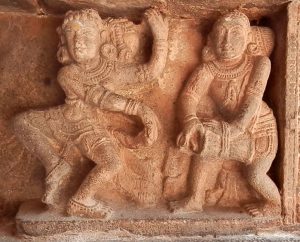
Dance is illustrated everywhere in the Chidambaram temple. The 108 karanas are illustrated in the gopurams. Dancers are depicted in reliefs on the base of the Raja Sabha and in the prakaram of the shrine of Shivakamasundari. Shiva’s Ananda Tandava is the main focus of course. This is Shiva’s dancing form in the Chit Sabha. The Nataraja is the presiding deity of the temple. And Shiva also dances his Urdhva Tandava in the Nritta Sabha together with goddess Kali.
As this is a blog post I will formulate my understanding of the relationship between these various representations of dance. And how we can see different aspects of dance play different roles within the sculptural program of the temple. And how realising this can help us understand these relationships within the broader context of tradition, mythology and ritual.
Dance is represented in Chidambaram and other South Indian temples in three aspects. These are related to function, situation and meaning. We can distinguish these as follows.
- Illustrations of dancers with musicians along the base of various shrines and courtyards.
- The 108 karanas as described by Bharata Muni in the Natya Shastra and illustrated in the entrance passages of the four gopurams.
- Shiva’s Tandava as worshipped as form of the presiding deity of the temple.
I would argue the presentation, placement and treatment of these three convey differences in meaning and function. Let me explain.
Karana, the coordination of the movement of hands and feet
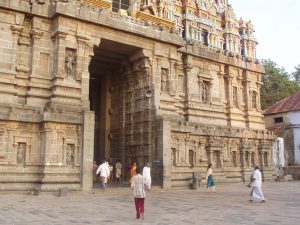
The 108 karanas are described in the Natya Shastra [link]. This is an ancient text on the performing arts. The author Bharata Muni tells us how the art of theatre was created by Brahma from the essence of the four Vedas. It is meant to hold up a mirror and educate those who do not have direct access to the Veda. A first play is put on and when presented on Mount Kailasha before Shiva the Lord is inspired to contribute abstract dance, Nritta, to this new art, inspired on Shiva’s own Sandhya Tandava[2].
Shiva instructs saint Tandu to teach Bharata the nritta, comprising of karanas, angaharas and recakas. This nritta was named as tandava, because of being explained by Tandu. These are all described in chapter four of the Natya Shastra. And the series of 108 karanas are illustrated in a handful of temples in South India. Of which Chidambaram is one. The dance was first performed by the Apsaras and Gandharvas in heaven. Later is was passed to humanity through the descendants of Bharata Muni.
All the 108 karanas are illustrated in the passageway the four gopurams as a continuous organised series. In the East and West gopuram the descriptive slokas from the Natya Shastra accompany the relief panels. The karanas are shown as performed by female dancers, accompanied by smaller musicians.
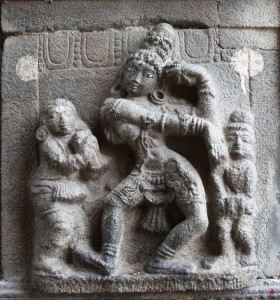
Dance as ritual offering
As the word karana (action) means a coordinated movement of the hands and feet, basically every individual dance movement can be called karana. This is often done by various researchers. And there is nothing wrong with this, but is can create confusion.
In this way the other dance reliefs found within the Chidambaram temple are often also referred to as karanas. This is not wrong as such. But when one studies and compares the clearly defined series of 108 in the gopuram and the relief panels found on the base of several shrines and prakaras it becomes quickly clear (at least for a trained dancer) they illustrate a different type of dance practice.
Although certain connections can be pointed out, and some of the movements shown could possibly be identified as one of the 108 karana from the Natya Sastra, the overall choreography of the dance shown is different. These panels do not illustrate a coordinated series of 108 individually identified movements. They illustrate elements from choreographies performed during processions or other rituals.
The dancers and the accompanying musicians are of the same height. Movements are repeated and varied upon. Symmetry is sometimes used in the composition. Story-telling elements (Nritya or Abhinaya) are part of some of the panels. As well as acrobatics with knives and trisulas, and playing with balls.
The Natya Shastra informs us the 108 karanas were combined to make 32 angaharas. These are choreographed combinations performed at certain points in the Natya, the drama. The various forms of Indian dance we know today do not use these angaharas. Bharata Natyam and Kuchipudi use different movements called adavu. Kathak performs tatkaar, rhythmical patterns. Odissi has the tribangi and chowka. The passing down of both the 108 karanas and the 32 angaharas through the guruparampara has been discontinued at some point in the past. Several laudable attempts at reconstruction have been presented in the past half century.
As the word karana can also be used in the general sense, a lot of confusion is sometimes the result. And the same Sanskrit names are sometimes used to refer to both karanas and tandavas, creating even more confusion.
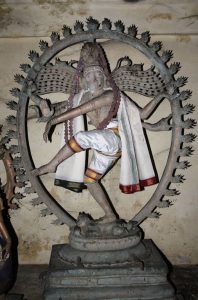
Tandava, Shiva’s vigorous masculine dance
Tandava is defined in Monier Williams as “dancing, especially with violent gesticulation, and particularly applied to the frantic dance of the god Siva”. Shiva’s Tandavas are many and varied. And Shiva is also depicted as performing the karanas in the incomplete series in the vimana of the Rajarajeshvara temple in Tanjore. I personally see Shiva’s Tandavas as representing a completely different level of dance from both the karanas as defined in the Natya Shastra and the dance choreographies depicted on the base of shrines in Chidambaram.
Shiva’s Tandavas are divine dance and reflect mythological episodes. Often connected to a particular place or events in heaven and on earth. They convey philosophical, esoteric and doctrinal meaning. This distinguishes them from both the 108 karanas of the Natya Shastra and other human, earthly dance. They are found in clearly defined sacred spaces. In the sanctum of temples. Sometimes illustrated on the gopuram or elsewhere in mythological context. But not depicted among the reliefs found on the base of shrines[3].
Confusion
The confusion starts as people use karana names to describe Tandavas. And also sometimes the names of Tandavas and karanas are similar or even the same. I will illustrate this further in another post, as otherwise this one becomes very long and technical. What I want to say is that this is a logical and legitimate use of technical terms from the Natya Shastra, in my opinion. But is does create confusion. Because the meaning of the Tandava and the karana is different.
As some academics seek to explain Tandavas in secular terms, it is also sometimes suggested the Tandava is a politically inspired design composed of two or more karanas. This creates an even deeper confusion. Especially for those who have no detailed knowledge of dance history and terminology.
To return to Shashi Kolar’s question about karanas and tandavas. I personally try to clarify this confusion by keeping the terminology clear and separate. This choice is bases on my study and experience. I state this when using technical terms from the Natya Shastra . And I do not call all depicted dance movements karana. Only when I can be sure the sculptor intended it as an illustration of one of the 108 described in the Natya Shastra[4]. The question of the relationship between the 108 karanas and other historical and contemporary forms of dance is still unsolved and part of my own research.
While writing this post I realised the best way to illustrate my points is to write another post using a specific example. I will go further into this subject on the comparison of the Gangavataran Tandava and the Gangavatarana Karana and others soon. Watch this space.
Sorry for using notes. I would prefer to avoid them in a blog like this. But I felt this added information would be helpful to some, while not helping the flow and understanding for others.
Liesbeth Pankaja
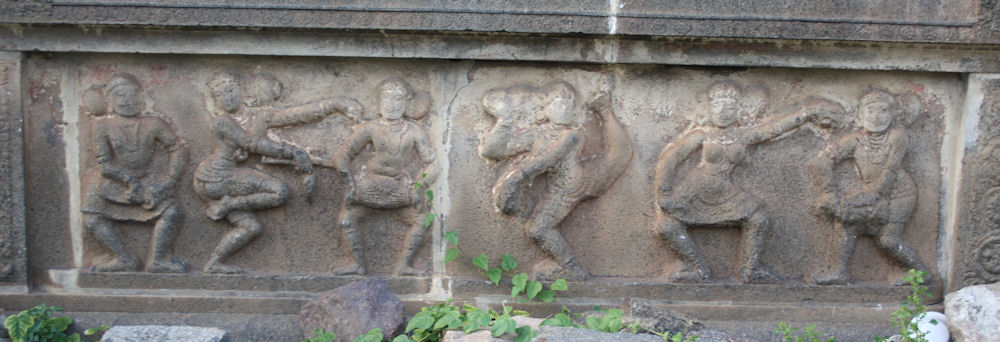
[1] While writing I realised it would become a very long post if I would do justice to the material and the argument. So I am splitting the general argument from the specific. And because fo how Facebook is organised I cant find the original post anymore, as usual. So I cant link to it.
[2] Bharata Muni’s Natya Shastra.
[3] Shiva dancing his Urdhva Tandava with Goddess Kali is depicted among the karanas found on the Sarangapani temple in Kumbakonamwith accompanying inscription. This is an exception.
[4] Sorry, another confusion is that I recently heard from Swarnamalya Ganesh that the tradition also knew Deshi Karanas. Which were movements evolved locally from the 108, as I understand it. Dr.Ganesh studied these for the PhD thesis. I am looking forward to the publication. I understand her work will offer clarification on the many questions of the evolution of the dance art in Southern India.
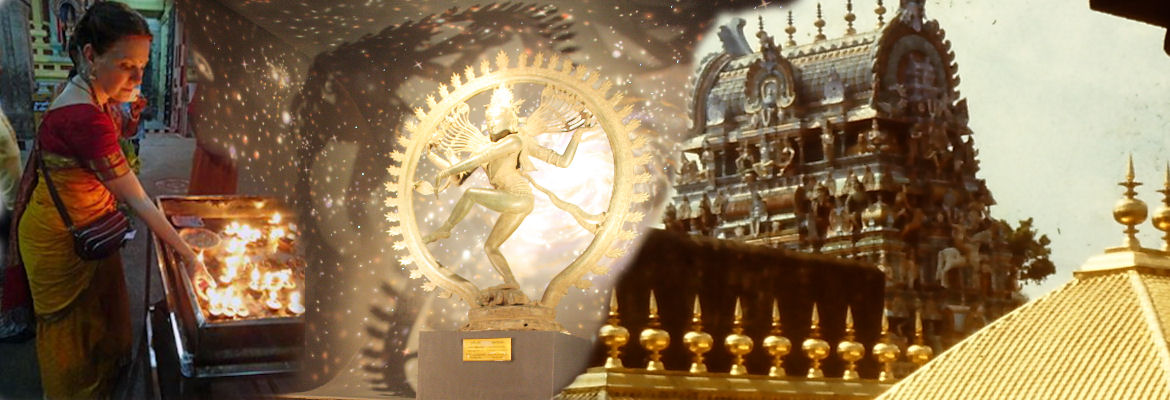
manju
i want to know about the 100th posture visnukranta.